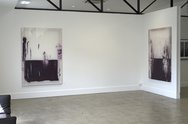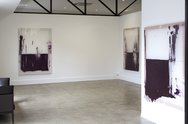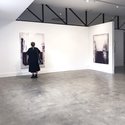John Hurrell – 13 November, 2020
For Wallis, the ghostly thin silk that exposes the supporting cedar bars and wall behind is a very effective foil for the squeegeed and scraped purple-brown paint. It makes the skins of paint or latex hover in front of the wall plane, so that the trapped space between the two is obvious, as is the objectness of the stretcher.
Five large paintings by Rebecca Wallis in the Scott Lawrie Gallery in Ponsonby exploit thick acrylic on translucent silk, dramatic dark maroon on ‘white’. Each has a dramatic horizon line that is almost halfway (or two or three fifths) up. One other work is on hessian.
The thick dark maroon (or occasionally thin chocolate) paint is usually like a peeling wrinkled skin; quite tactile; sometimes lumpy. It tends to be torn and raggedy; dominated by organic shapes with ripped edges. Wallis also uses darker puddles of jagged, streaky, transparent latex directly on the milky silk.
In these tonally contrasting Ab-Ex paintings there are geysers of intricate showered or dripped spotty marks that are fine and delicate—almost graphic. From a distance however, these works are reminiscent of mid-seventies Stephen Bambury, but not paired monochromes or blocks of deep tone—being much rawer and more tactile, with a strong sense of disintegration.
For Wallis, the ghostly thin silk that exposes the supporting cedar bars and wall behind is a very effective foil for the squeegeed and scraped purple-brown paint. It makes the skins of paint or latex hover in front of the wall plane, so that the trapped space between the two is obvious, as is the objectness of the stretcher. Vertical spatial layering via opacity and reflection is thus emphasised.
As there is no white ground on which the maroon rests—for the latex is crucial—the works initially avoid overt illusion and any sense of receding space. The picture plane is implied, albeit ethereal. The striations and tattered fields of acrylic float on the soft pale-grey air, a portrait format split in two to eventually become an ancient landscape.
At a certain point this nervous horizontal edge—especially with the pale sky—has started to evoke distant flat vistas, interrupted by blurred treelike slashes; marks and materials that recall primal memories and hints of Surrealism. Such imaginative notions frantically flee the physically insistent (but soon to be forgotten) oozy and blistering paint, screens of evanescent gauze, and discreetly lurking bars of cedar.
John Hurrell










 Two Rooms presents a program of residencies and projects
Two Rooms presents a program of residencies and projects Advertising in this column
Advertising in this column



This Discussion has 0 comments.
Comment
Participate
Register to Participate.
Sign in
Sign in to an existing account.